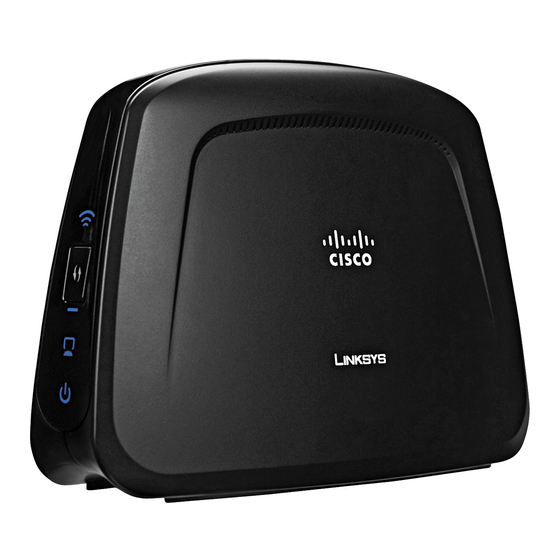- ページ 14
無線アクセスポイント Cisco Linksys WAP610NのPDF ユーザーマニュアルをオンラインで閲覧またはダウンロードできます。Cisco Linksys WAP610N 41 ページ。 Wireless-n access point with dual-band
Cisco Linksys WAP610N にも: クイック・インストール・マニュアル (8 ページ)

Chapter 3
Wireless > Advanced Wireless Settings
Configure the Access Point's advanced wireless functions.
These settings should only be adjusted by an expert
administrator as incorrect settings can reduce wireless
performance.
Wireless > Advanced Wireless Settings
NOTE:
The settings on the Advanced Wireless
Settings screen are designed for advanced users
only.
Advanced Wireless
AP Isolation
This isolates all wireless clients and wireless
devices on your network from each other. Wireless devices
will be able to communicate with the Access Point but not
with each other. To use this function, select Enabled. AP
Isolation is disabled by default.
Authentication Type
The Authentication Type setting
is available if the Security mode is WEP. The default is
set to Auto, which allows either Open System or Shared
Key authentication to be used. With Open System
authentication, the sender and the recipient do NOT
use a WEP key for authentication. With Shared Key
authentication, the sender and recipient use a WEP key for
authentication. Select Shared Key to only use Shared Key
authentication.
Basic Rate
The Basic Rate setting is not actually one rate
of transmission but a series of rates at which the Access
Point can transmit. The Access Point will advertise its
Basic Rate to the other wireless devices in your network,
so they know which rates will be used. The Access Point
will also advertise that it will automatically select the best
rate for transmission. The default setting is Default, when
the Access Point can transmit at all standard wireless
rates (1-2Mbps, 5.5Mbps, 11Mbps, 18Mbps, and 24Mbps).
Other options are 1-2Mbps, for use with older wireless
technology, and All, when the Access Point can transmit
at all wireless rates. The Basic Rate is not the actual rate of
Wireless-N Access Point with Dual-Band
Advanced Configuration
data transmission. If you want to specify the Access Point's
rate of data transmission, configure the Transmission Rate
setting.
Transmission Rate
The Transmission Rate setting is
available if the Network Mode is set to Wireless-B/G Only,
Wireless-G Only, Wireless-B Only, Wireless-A Only, or Mixed.
The rate of data transmission should be set depending on
the speed of your wireless network. You can select from
a range of transmission speeds, or you can select Auto
to have the Access Point automatically use the fastest
possible data rate and enable the Auto-Fallback feature.
Auto-Fallback will negotiate the best possible connection
speed between the Access Point and a wireless client. The
default is Auto.
N Transmission Rate
The N Transmission Rate setting is
available if the Network Mode is set to Mixed or Wireless-N
Only. The rate of data transmission should be set
depending on the speed of your Wireless-N networking.
You can select from a range of transmission speeds, or you
can select Auto to have the Access Point automatically
use the fastest possible data rate and enable the Auto-
Fallback feature. Auto-Fallback will negotiate the best
possible connection speed between the Access Point and
a wireless client. The default is Auto.
Transmission Power
This option sets the percentage
of maximal transmit power relative to the regulatory
domain restrictions. For example, if the regulatory domain
restriction allows transmissions of up to 20 dB, then setting
the percentage at 50% allows maximal transmit power of
10 dB. Select the percentage you want to use: 12%, 25%,
50%, or 100%. The default is 100%.
CTS Protection Mode
The Access Point will automatically
use CTS (Clear-To-Send) Protection Mode when your
Wireless-N and Wireless-G products are experiencing
severe problems and are not able to transmit to the
Access Point in an environment with heavy 802.11b traffic.
This function boosts the Access Point's ability to catch all
Wireless-N and Wireless-G transmissions but will severely
decrease performance. The default is Auto. To disable this
option, select Disabled.
Beacon Interval
Enter a value between 20 and 1000
milliseconds. The Beacon Interval value indicates the
frequency interval of the beacon. A beacon is a packet
broadcast by the Access Point to synchronize the wireless
network. The default value is 100.
DTIM Interval
This value, between 1 and 255, indicates
the interval of the Delivery Traffic Indication Message
(DTIM). A DTIM field is a countdown field informing
clients of the next window for listening to broadcast and
multicast messages. When the Access Point has buffered
broadcast or multicast messages for associated clients, it
sends the next DTIM with a DTIM Interval value. Its clients
hear the beacons and awaken to receive the broadcast
and multicast messages. The default value is 1.
11
